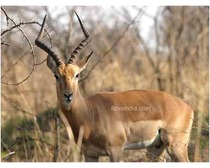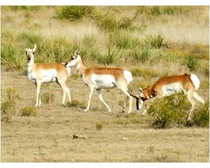The term ‘antelope’ represents a mammal species, which belongs to the Bovidae family. With this article, explore some interesting facts & amazing information on antelopes.
Facts About Antelope
Antelope is a mammal species that is found to be a part of the Bovidae family. However, not all members of Bovidae family are to be considered antelopes. The term ‘antelopes’ refers to a miscellaneous group within the Bovidae family, which consists of species that cannot be categorized as cattle, sheep, buffalo, bison, or goats. Antelopes belong to the even-toed species of ruminant mammals, which are herbivores. There are over 90 species of Antelope in the world and they vary from each other in their appearance, habitat strategy and range. Antelopes are mostly found in Africa, but some of also exist in Asia and North America; however, no antelopes are native to Australia or Antarctica. These animals are found in various shapes, sizes and colors. Their horns also come in different size and shapes. A group of Antelopes can be referred to as a 'herd'. Read on to explore some more interesting facts & amazing information on antelopes. 

Fast Facts
Kingdom: Animalia
Phylum: Chordata
Class: Mammalia
Order: Artiodactyla
Family: Bovidae
Genus: About 30 genera
Species: About 90
Length: 150 cm (59 in)
Weight: 589kg (1,300lbs)
Top Speed: 70km/h (43mph)
Age: 10 years
Diet: Herbivorous (grass, shoots, seeds)
Habitat: Woodlands, forests, savannahs, grassland plains, and marshes.
Number of Offspring: One
Interesting & Amazing Information On Antelopes
- There are over 90 species classified under the group ‘antelope’. However, all of them widely vary in appearance, strategy, habitat, and range. In other words, you will find very few of them displaying similar characteristics.
- The term ‘antelope’ has been is derived from the Old French antelop, itself derived from Medieval Latin ant(h)alopus, which in turn comes from the Byzantine Greek word anthólops (anthos meaning ‘flower’ and ops meaning ‘eye’).
- The ‘antelope’ group has not been taxonomically defined. Rather, it includes all those members of the family Bovidae that do not fall under the category of sheep, cattle, or goat.
- Majority of the antelopes are found in Africa, with a few inhabiting parts of Asia and America as well.
- You can find the Arabian Oryx and Dorcas Gazelle in Arabian Peninsula, while India is home to Nilgai, Chinkara and Blackbuck. Russia and Southeast Asia are inhabited by the Four-horned Antelope, Tibetan Antelope and Saiga Antelope.
- Talking about the physical characteristics of antelopes, all of them have even-toed hooves, horizontal pupils, ruminating guts, and (in at least the males) bony horns.
- Though antelopes look a lot like deer, they constitute an entirely different species. And unlike deer, they do not renew their horns annually. Rather, they have strong, permanent horns.
- Antelopes use their horns mainly for the purpose of defending their antelope herd or fighting other antelopes.
- Since antelopes are hunted by many large animals, they hardly live beyond 8 to 10 years, in the wild.
- You will always find antelopes living in herds, which usually consist of 2-4 females and just one male.
- About 25 species of antelopes have been rated as endangered by the IUCN, which include the dama gazelle and the mountain nyala.
- A few species of antelope can be seen living in the mountains and rocky outcrops, while a few have adapted themselves to deserts (both hot and cold). Then, there are some species that are even semi-aquatic in nature and live in swamps.
- The smallest of all the species of antelopes is the Royal antelope. It is 10-12 inches tall, almost the size of a rabbit.
- The largest antelope is the eland, which is also the slowest.
- A few antelope species have horns on both the male and the females. Usually, the larger species, such as eland and roan, have horns on both the sexes
- Horns of some antelopes can grow up to 5ft. long.
- Antelopes’ horns are high in medicinal value, one more reason for which they are hunted.
- The horns of an antelope are hard and hollow, which grow all through the antelope’s life.
- Antelopes are extremely alert animals. They can sense danger very quickly and since they are fast runners they can quickly get away from the site of danger.


See also
More from iloveindia.com
- Home Remedies | Ayurveda | Vastu | Yoga | Feng Shui | Tattoos | Fitness | Garden | Nutrition | Parenting | Bikes | Cars | Baby Care | Indian Weddings | Festivals | Party ideas | Horoscope 2015 | Pets | Finance | Figures of Speech | Hotels in India : Delhi | Hyderabad | Chennai | Mumbai | Kolkata | Bangalore | Ahmedabad | Jaipur
- Contact Us Careers Disclaimer Privacy Policy Advertise With Us Lifestyle Sitemap Copyright iloveindia.com. All Rights Reserved.




